Health Promotion in Healthcare: Case Study on Ru Shi's Pre-diabetes
VerifiedAdded on 2023/01/18
|13
|4495
|60
Report
AI Summary
This report examines health promotion strategies relevant to a case study involving Ru Shi, a 28-year-old mother diagnosed with pre-diabetes. The introduction defines health promotion and its significance in healthcare, referencing relevant policies. The evidence base explores the impact of lifestyle factors on health, particularly concerning pre-diabetes, and relates these factors to Ru Shi's situation. The report then conducts a needs assessment, identifying the most appropriate level of health promotion work for Ru Shi, which is determined to be tertiary prevention. It establishes a SMART aim and objectives to limit the progression of her pre-diabetes. It discusses various health promotion approaches, including educational, behavioral change, and client-centered approaches, and explains their relevance to the case. Finally, the report explores the use of different health promotion models, such as the behavioral change model, to facilitate positive health outcomes and promote healthy lifestyles for individuals with pre-diabetes.
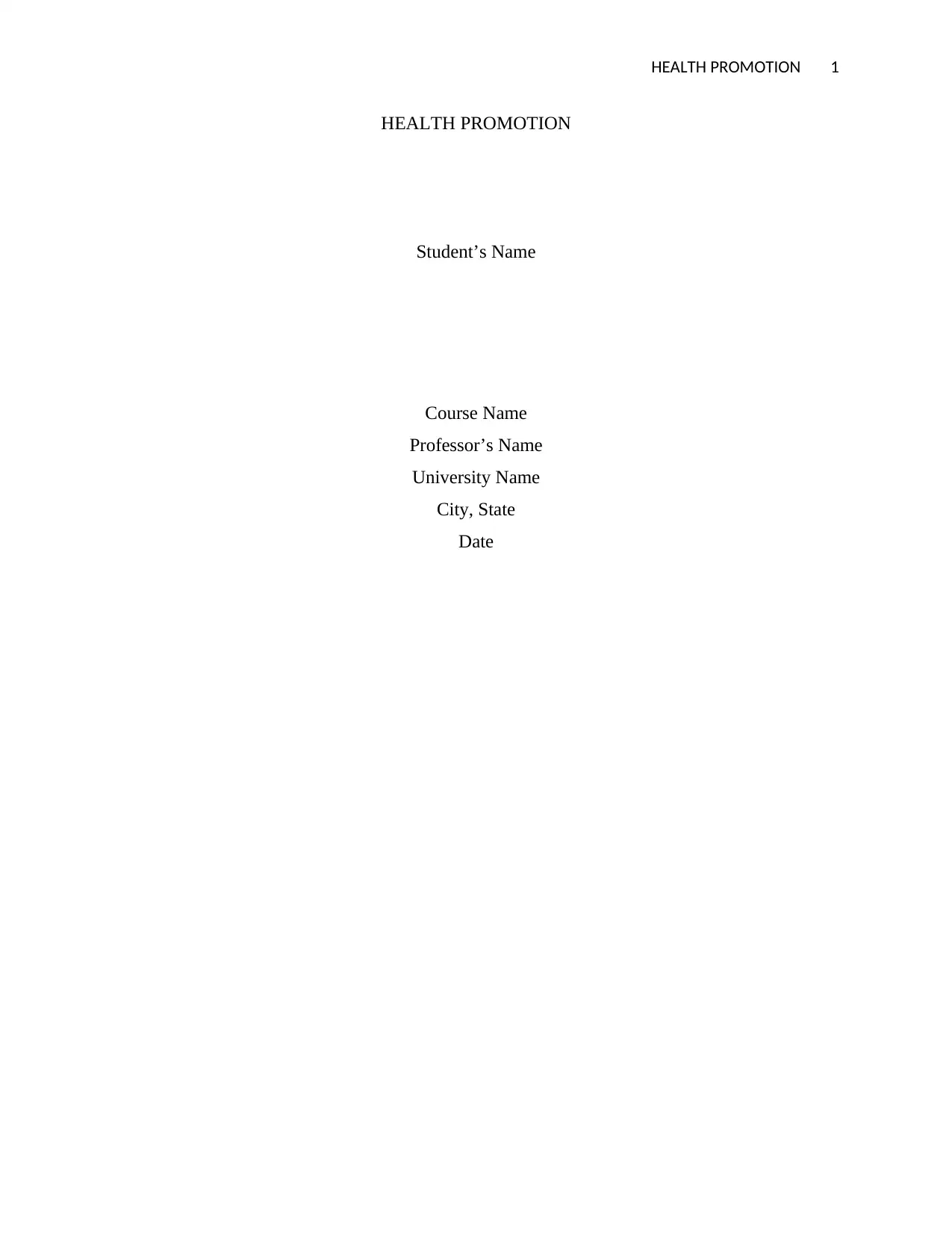
HEALTH PROMOTION 1
HEALTH PROMOTION
Student’s Name
Course Name
Professor’s Name
University Name
City, State
Date
HEALTH PROMOTION
Student’s Name
Course Name
Professor’s Name
University Name
City, State
Date
Paraphrase This Document
Need a fresh take? Get an instant paraphrase of this document with our AI Paraphraser
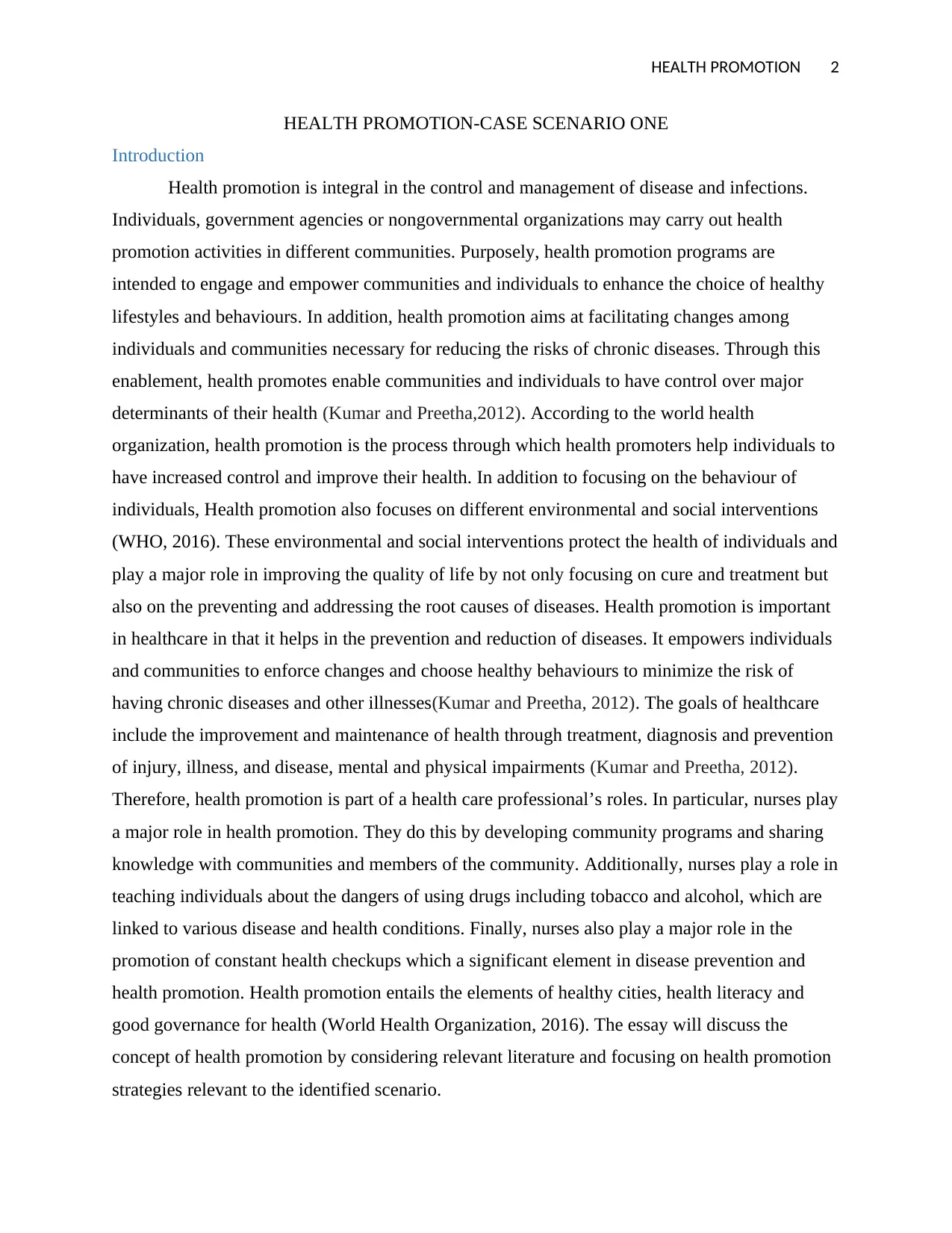
HEALTH PROMOTION 2
HEALTH PROMOTION-CASE SCENARIO ONE
Introduction
Health promotion is integral in the control and management of disease and infections.
Individuals, government agencies or nongovernmental organizations may carry out health
promotion activities in different communities. Purposely, health promotion programs are
intended to engage and empower communities and individuals to enhance the choice of healthy
lifestyles and behaviours. In addition, health promotion aims at facilitating changes among
individuals and communities necessary for reducing the risks of chronic diseases. Through this
enablement, health promotes enable communities and individuals to have control over major
determinants of their health (Kumar and Preetha,2012). According to the world health
organization, health promotion is the process through which health promoters help individuals to
have increased control and improve their health. In addition to focusing on the behaviour of
individuals, Health promotion also focuses on different environmental and social interventions
(WHO, 2016). These environmental and social interventions protect the health of individuals and
play a major role in improving the quality of life by not only focusing on cure and treatment but
also on the preventing and addressing the root causes of diseases. Health promotion is important
in healthcare in that it helps in the prevention and reduction of diseases. It empowers individuals
and communities to enforce changes and choose healthy behaviours to minimize the risk of
having chronic diseases and other illnesses(Kumar and Preetha, 2012). The goals of healthcare
include the improvement and maintenance of health through treatment, diagnosis and prevention
of injury, illness, and disease, mental and physical impairments (Kumar and Preetha, 2012).
Therefore, health promotion is part of a health care professional’s roles. In particular, nurses play
a major role in health promotion. They do this by developing community programs and sharing
knowledge with communities and members of the community. Additionally, nurses play a role in
teaching individuals about the dangers of using drugs including tobacco and alcohol, which are
linked to various disease and health conditions. Finally, nurses also play a major role in the
promotion of constant health checkups which a significant element in disease prevention and
health promotion. Health promotion entails the elements of healthy cities, health literacy and
good governance for health (World Health Organization, 2016). The essay will discuss the
concept of health promotion by considering relevant literature and focusing on health promotion
strategies relevant to the identified scenario.
HEALTH PROMOTION-CASE SCENARIO ONE
Introduction
Health promotion is integral in the control and management of disease and infections.
Individuals, government agencies or nongovernmental organizations may carry out health
promotion activities in different communities. Purposely, health promotion programs are
intended to engage and empower communities and individuals to enhance the choice of healthy
lifestyles and behaviours. In addition, health promotion aims at facilitating changes among
individuals and communities necessary for reducing the risks of chronic diseases. Through this
enablement, health promotes enable communities and individuals to have control over major
determinants of their health (Kumar and Preetha,2012). According to the world health
organization, health promotion is the process through which health promoters help individuals to
have increased control and improve their health. In addition to focusing on the behaviour of
individuals, Health promotion also focuses on different environmental and social interventions
(WHO, 2016). These environmental and social interventions protect the health of individuals and
play a major role in improving the quality of life by not only focusing on cure and treatment but
also on the preventing and addressing the root causes of diseases. Health promotion is important
in healthcare in that it helps in the prevention and reduction of diseases. It empowers individuals
and communities to enforce changes and choose healthy behaviours to minimize the risk of
having chronic diseases and other illnesses(Kumar and Preetha, 2012). The goals of healthcare
include the improvement and maintenance of health through treatment, diagnosis and prevention
of injury, illness, and disease, mental and physical impairments (Kumar and Preetha, 2012).
Therefore, health promotion is part of a health care professional’s roles. In particular, nurses play
a major role in health promotion. They do this by developing community programs and sharing
knowledge with communities and members of the community. Additionally, nurses play a role in
teaching individuals about the dangers of using drugs including tobacco and alcohol, which are
linked to various disease and health conditions. Finally, nurses also play a major role in the
promotion of constant health checkups which a significant element in disease prevention and
health promotion. Health promotion entails the elements of healthy cities, health literacy and
good governance for health (World Health Organization, 2016). The essay will discuss the
concept of health promotion by considering relevant literature and focusing on health promotion
strategies relevant to the identified scenario.

HEALTH PROMOTION 3
Evidence Base
The term overweight is used to refer to body weight that is more than healthy or normal
weight for different body height. Extra body fact causes individuals to become overweight. This
definition is based on body mass index, whereby individuals with body mass index of between
25 and 30. According to the World Health Organization (2018) the number of overweight
individuals in the world has been on the rise in the recent past. According to 2016 statistics,
about 1,9 billion adults were overweight. In addition, the statistic showed that 39% of adults
aged above 18 years were overweight. In addition, 41 million children aged below 5 were also
found to be obese in the same year (World Health Organization, 2018). Being obese may lead to
multiple health problems including pre-diabetes, type two diabetes, high blood pressure, fatty
liver disease and certain types of cancers. Prediabetes is a situation in which blood glucose levels
are above the normal level but not as high for an individual to be diagnosed with diabetes.
Prediabetes could develop to type 2-diabetes overtime (Basu, 2019).
According to Huizen (2019), individuals with prediabetes become unable to use insulin
correctly leading to the presence of too much blood sugar in the old stream. Therefore, this can
lead to damage of kidneys, the heart and blood vessels. These are the likely outcomes in Ru Shi’s
health (Weatherspoon, 2019).
According to the Centre for Disease Control and Prevention (2018), more than 84 million
American adults have pre-diabetes. About 90% of these people are not aware if they have the
condition. A study carried out in Hong Kong between 2014 and 2016 established that 50% of
individuals aged 15 and above were overweight. These statistics presented a rise from 17.8% to
20.1% in a period of 10 years (Xinqi, 2017).
Pre-diabetes is linked to many factors. Genetic factors are a common cause of pre-
diabetes. This means that an individual stands a higher risk of developing the disease if it runs in
the family (The Right Diet for Prediabetes, 2019). In addition, lifestyle factors may play a major
role in the development of the disease. For example, the consumption of foods with high
amounts of fats, starches and sugar overload the body with more glucose than required
(American Heart Association, 2015). Sedentary lifestyles and excess body fats are also risk
factors for pre-diabetes. For Ru Shi, unhealthy eating habits, sedentary lifestyle and genetic
factors can be linked to her condition. Consumption of healthy food choices such as whole
grains, vegetables and fruits can reduce the risk of pre-diabetes
Evidence Base
The term overweight is used to refer to body weight that is more than healthy or normal
weight for different body height. Extra body fact causes individuals to become overweight. This
definition is based on body mass index, whereby individuals with body mass index of between
25 and 30. According to the World Health Organization (2018) the number of overweight
individuals in the world has been on the rise in the recent past. According to 2016 statistics,
about 1,9 billion adults were overweight. In addition, the statistic showed that 39% of adults
aged above 18 years were overweight. In addition, 41 million children aged below 5 were also
found to be obese in the same year (World Health Organization, 2018). Being obese may lead to
multiple health problems including pre-diabetes, type two diabetes, high blood pressure, fatty
liver disease and certain types of cancers. Prediabetes is a situation in which blood glucose levels
are above the normal level but not as high for an individual to be diagnosed with diabetes.
Prediabetes could develop to type 2-diabetes overtime (Basu, 2019).
According to Huizen (2019), individuals with prediabetes become unable to use insulin
correctly leading to the presence of too much blood sugar in the old stream. Therefore, this can
lead to damage of kidneys, the heart and blood vessels. These are the likely outcomes in Ru Shi’s
health (Weatherspoon, 2019).
According to the Centre for Disease Control and Prevention (2018), more than 84 million
American adults have pre-diabetes. About 90% of these people are not aware if they have the
condition. A study carried out in Hong Kong between 2014 and 2016 established that 50% of
individuals aged 15 and above were overweight. These statistics presented a rise from 17.8% to
20.1% in a period of 10 years (Xinqi, 2017).
Pre-diabetes is linked to many factors. Genetic factors are a common cause of pre-
diabetes. This means that an individual stands a higher risk of developing the disease if it runs in
the family (The Right Diet for Prediabetes, 2019). In addition, lifestyle factors may play a major
role in the development of the disease. For example, the consumption of foods with high
amounts of fats, starches and sugar overload the body with more glucose than required
(American Heart Association, 2015). Sedentary lifestyles and excess body fats are also risk
factors for pre-diabetes. For Ru Shi, unhealthy eating habits, sedentary lifestyle and genetic
factors can be linked to her condition. Consumption of healthy food choices such as whole
grains, vegetables and fruits can reduce the risk of pre-diabetes
⊘ This is a preview!⊘
Do you want full access?
Subscribe today to unlock all pages.

Trusted by 1+ million students worldwide
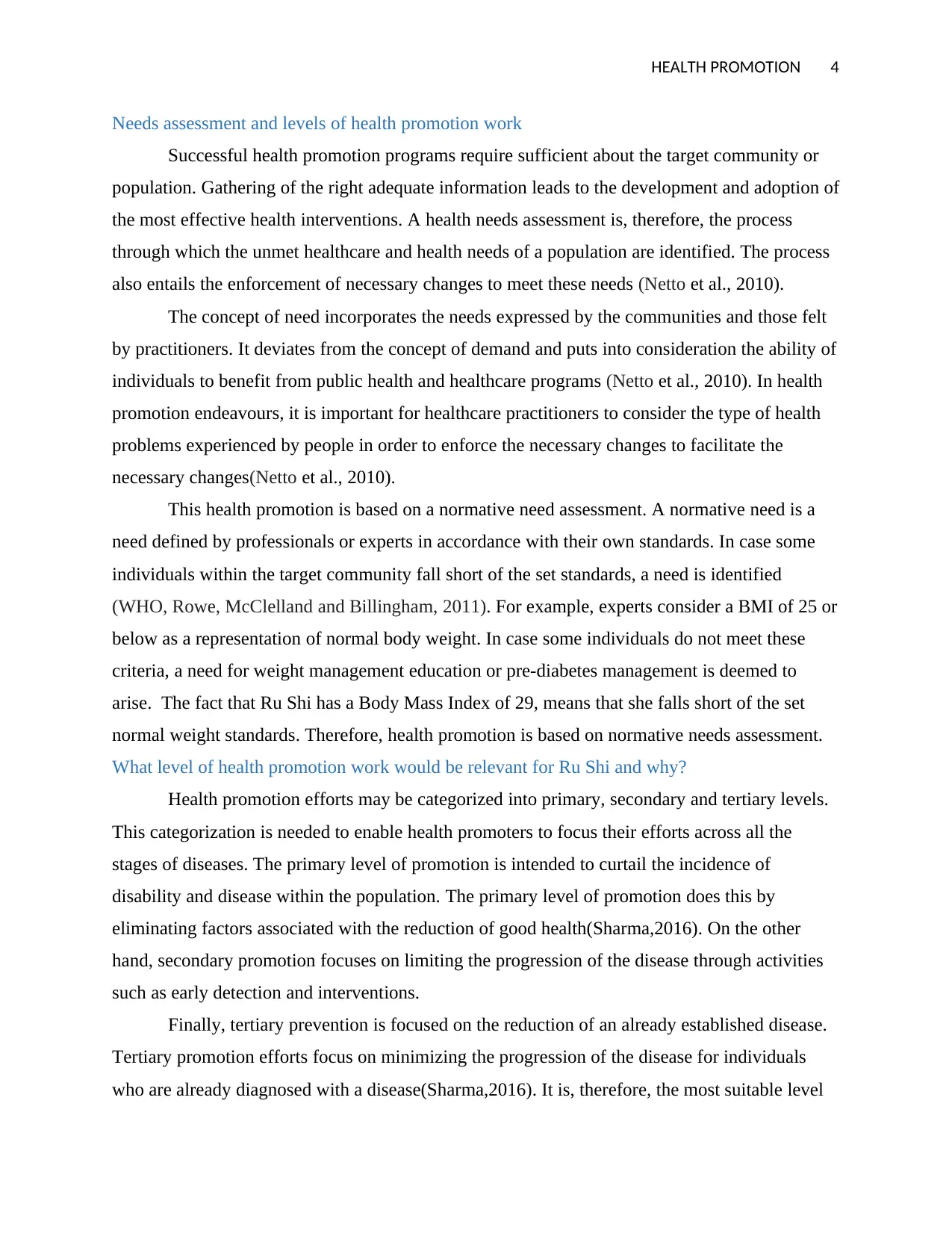
HEALTH PROMOTION 4
Needs assessment and levels of health promotion work
Successful health promotion programs require sufficient about the target community or
population. Gathering of the right adequate information leads to the development and adoption of
the most effective health interventions. A health needs assessment is, therefore, the process
through which the unmet healthcare and health needs of a population are identified. The process
also entails the enforcement of necessary changes to meet these needs (Netto et al., 2010).
The concept of need incorporates the needs expressed by the communities and those felt
by practitioners. It deviates from the concept of demand and puts into consideration the ability of
individuals to benefit from public health and healthcare programs (Netto et al., 2010). In health
promotion endeavours, it is important for healthcare practitioners to consider the type of health
problems experienced by people in order to enforce the necessary changes to facilitate the
necessary changes(Netto et al., 2010).
This health promotion is based on a normative need assessment. A normative need is a
need defined by professionals or experts in accordance with their own standards. In case some
individuals within the target community fall short of the set standards, a need is identified
(WHO, Rowe, McClelland and Billingham, 2011). For example, experts consider a BMI of 25 or
below as a representation of normal body weight. In case some individuals do not meet these
criteria, a need for weight management education or pre-diabetes management is deemed to
arise. The fact that Ru Shi has a Body Mass Index of 29, means that she falls short of the set
normal weight standards. Therefore, health promotion is based on normative needs assessment.
What level of health promotion work would be relevant for Ru Shi and why?
Health promotion efforts may be categorized into primary, secondary and tertiary levels.
This categorization is needed to enable health promoters to focus their efforts across all the
stages of diseases. The primary level of promotion is intended to curtail the incidence of
disability and disease within the population. The primary level of promotion does this by
eliminating factors associated with the reduction of good health(Sharma,2016). On the other
hand, secondary promotion focuses on limiting the progression of the disease through activities
such as early detection and interventions.
Finally, tertiary prevention is focused on the reduction of an already established disease.
Tertiary promotion efforts focus on minimizing the progression of the disease for individuals
who are already diagnosed with a disease(Sharma,2016). It is, therefore, the most suitable level
Needs assessment and levels of health promotion work
Successful health promotion programs require sufficient about the target community or
population. Gathering of the right adequate information leads to the development and adoption of
the most effective health interventions. A health needs assessment is, therefore, the process
through which the unmet healthcare and health needs of a population are identified. The process
also entails the enforcement of necessary changes to meet these needs (Netto et al., 2010).
The concept of need incorporates the needs expressed by the communities and those felt
by practitioners. It deviates from the concept of demand and puts into consideration the ability of
individuals to benefit from public health and healthcare programs (Netto et al., 2010). In health
promotion endeavours, it is important for healthcare practitioners to consider the type of health
problems experienced by people in order to enforce the necessary changes to facilitate the
necessary changes(Netto et al., 2010).
This health promotion is based on a normative need assessment. A normative need is a
need defined by professionals or experts in accordance with their own standards. In case some
individuals within the target community fall short of the set standards, a need is identified
(WHO, Rowe, McClelland and Billingham, 2011). For example, experts consider a BMI of 25 or
below as a representation of normal body weight. In case some individuals do not meet these
criteria, a need for weight management education or pre-diabetes management is deemed to
arise. The fact that Ru Shi has a Body Mass Index of 29, means that she falls short of the set
normal weight standards. Therefore, health promotion is based on normative needs assessment.
What level of health promotion work would be relevant for Ru Shi and why?
Health promotion efforts may be categorized into primary, secondary and tertiary levels.
This categorization is needed to enable health promoters to focus their efforts across all the
stages of diseases. The primary level of promotion is intended to curtail the incidence of
disability and disease within the population. The primary level of promotion does this by
eliminating factors associated with the reduction of good health(Sharma,2016). On the other
hand, secondary promotion focuses on limiting the progression of the disease through activities
such as early detection and interventions.
Finally, tertiary prevention is focused on the reduction of an already established disease.
Tertiary promotion efforts focus on minimizing the progression of the disease for individuals
who are already diagnosed with a disease(Sharma,2016). It is, therefore, the most suitable level
Paraphrase This Document
Need a fresh take? Get an instant paraphrase of this document with our AI Paraphraser

HEALTH PROMOTION 5
of Ru Shi. The reason for this is because she has already been diagnosed with pre-diabetes.
Tertiary promotion would, therefore, ensure that the disease does not progress to type 2
diabetes.It would also lead to the improvement of her quality of life.
SMART aim and SMART objectives
Smart aim
To limit the progression of Ru shi’s pre-diabetes to type 2 diabetes
Objectives
To improve Ru Shi’s health through health literacy and creation of awareness on proper dietary
choices
To facilitate lifestyle changes through increased body activity
What approaches could be used and why?
Health promotion approaches are designed to promote health with various methods
depending on the objectives they intend to achieve. Therefore, the effectiveness of different
health promotion approaches may vary. Generally, there are 5 approaches used in health
promotion, these include medical approach, educational approach, behavioural change approach,
client-centred approach and societal change approach (Janssen, Van Regenmortel and
Abma,2014).
Firstly, the educational approach is aimed at providing individuals with the necessary
information to enhance their understanding and knowledge on health issues. The assumption is
that when individuals are informed they stand a better chance of making better decisions
regarding their health. The educational approach may also facilitate the adoption of new
approaches intended to improve health outcomes. Through this approach, health professionals
embolden individuals to make their own choices. The approach could be used in the scenario to
create awareness on factors that could have led Ru Shi to become overweight as well as what
needs to be done to achieve the desired body weight(Janssen, Van Regenmortel and
Abma,2014).
Secondly, the behavioural change approach focuses on changing the behaviours and
attitudes of individuals to enhance the adoption of healthy lifestyles. Some of the issues that have
made Ru Shi become pre-diabetic include unhealthy eating habits and the adoption of a lifestyle
with less body activity. Therefore, an individual like Ru Shi may be taught how to change her
of Ru Shi. The reason for this is because she has already been diagnosed with pre-diabetes.
Tertiary promotion would, therefore, ensure that the disease does not progress to type 2
diabetes.It would also lead to the improvement of her quality of life.
SMART aim and SMART objectives
Smart aim
To limit the progression of Ru shi’s pre-diabetes to type 2 diabetes
Objectives
To improve Ru Shi’s health through health literacy and creation of awareness on proper dietary
choices
To facilitate lifestyle changes through increased body activity
What approaches could be used and why?
Health promotion approaches are designed to promote health with various methods
depending on the objectives they intend to achieve. Therefore, the effectiveness of different
health promotion approaches may vary. Generally, there are 5 approaches used in health
promotion, these include medical approach, educational approach, behavioural change approach,
client-centred approach and societal change approach (Janssen, Van Regenmortel and
Abma,2014).
Firstly, the educational approach is aimed at providing individuals with the necessary
information to enhance their understanding and knowledge on health issues. The assumption is
that when individuals are informed they stand a better chance of making better decisions
regarding their health. The educational approach may also facilitate the adoption of new
approaches intended to improve health outcomes. Through this approach, health professionals
embolden individuals to make their own choices. The approach could be used in the scenario to
create awareness on factors that could have led Ru Shi to become overweight as well as what
needs to be done to achieve the desired body weight(Janssen, Van Regenmortel and
Abma,2014).
Secondly, the behavioural change approach focuses on changing the behaviours and
attitudes of individuals to enhance the adoption of healthy lifestyles. Some of the issues that have
made Ru Shi become pre-diabetic include unhealthy eating habits and the adoption of a lifestyle
with less body activity. Therefore, an individual like Ru Shi may be taught how to change her
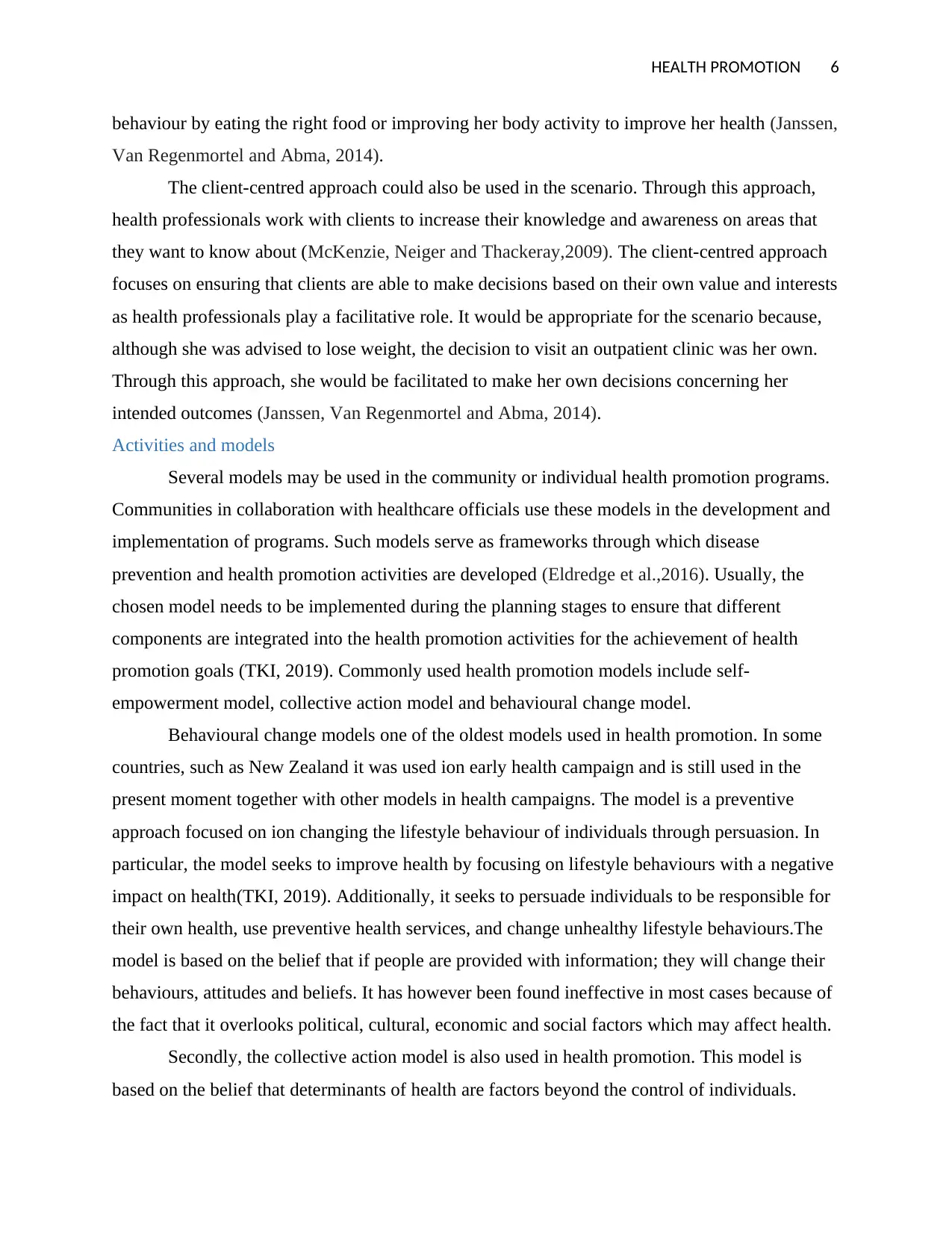
HEALTH PROMOTION 6
behaviour by eating the right food or improving her body activity to improve her health (Janssen,
Van Regenmortel and Abma, 2014).
The client-centred approach could also be used in the scenario. Through this approach,
health professionals work with clients to increase their knowledge and awareness on areas that
they want to know about (McKenzie, Neiger and Thackeray,2009). The client-centred approach
focuses on ensuring that clients are able to make decisions based on their own value and interests
as health professionals play a facilitative role. It would be appropriate for the scenario because,
although she was advised to lose weight, the decision to visit an outpatient clinic was her own.
Through this approach, she would be facilitated to make her own decisions concerning her
intended outcomes (Janssen, Van Regenmortel and Abma, 2014).
Activities and models
Several models may be used in the community or individual health promotion programs.
Communities in collaboration with healthcare officials use these models in the development and
implementation of programs. Such models serve as frameworks through which disease
prevention and health promotion activities are developed (Eldredge et al.,2016). Usually, the
chosen model needs to be implemented during the planning stages to ensure that different
components are integrated into the health promotion activities for the achievement of health
promotion goals (TKI, 2019). Commonly used health promotion models include self-
empowerment model, collective action model and behavioural change model.
Behavioural change models one of the oldest models used in health promotion. In some
countries, such as New Zealand it was used ion early health campaign and is still used in the
present moment together with other models in health campaigns. The model is a preventive
approach focused on ion changing the lifestyle behaviour of individuals through persuasion. In
particular, the model seeks to improve health by focusing on lifestyle behaviours with a negative
impact on health(TKI, 2019). Additionally, it seeks to persuade individuals to be responsible for
their own health, use preventive health services, and change unhealthy lifestyle behaviours.The
model is based on the belief that if people are provided with information; they will change their
behaviours, attitudes and beliefs. It has however been found ineffective in most cases because of
the fact that it overlooks political, cultural, economic and social factors which may affect health.
Secondly, the collective action model is also used in health promotion. This model is
based on the belief that determinants of health are factors beyond the control of individuals.
behaviour by eating the right food or improving her body activity to improve her health (Janssen,
Van Regenmortel and Abma, 2014).
The client-centred approach could also be used in the scenario. Through this approach,
health professionals work with clients to increase their knowledge and awareness on areas that
they want to know about (McKenzie, Neiger and Thackeray,2009). The client-centred approach
focuses on ensuring that clients are able to make decisions based on their own value and interests
as health professionals play a facilitative role. It would be appropriate for the scenario because,
although she was advised to lose weight, the decision to visit an outpatient clinic was her own.
Through this approach, she would be facilitated to make her own decisions concerning her
intended outcomes (Janssen, Van Regenmortel and Abma, 2014).
Activities and models
Several models may be used in the community or individual health promotion programs.
Communities in collaboration with healthcare officials use these models in the development and
implementation of programs. Such models serve as frameworks through which disease
prevention and health promotion activities are developed (Eldredge et al.,2016). Usually, the
chosen model needs to be implemented during the planning stages to ensure that different
components are integrated into the health promotion activities for the achievement of health
promotion goals (TKI, 2019). Commonly used health promotion models include self-
empowerment model, collective action model and behavioural change model.
Behavioural change models one of the oldest models used in health promotion. In some
countries, such as New Zealand it was used ion early health campaign and is still used in the
present moment together with other models in health campaigns. The model is a preventive
approach focused on ion changing the lifestyle behaviour of individuals through persuasion. In
particular, the model seeks to improve health by focusing on lifestyle behaviours with a negative
impact on health(TKI, 2019). Additionally, it seeks to persuade individuals to be responsible for
their own health, use preventive health services, and change unhealthy lifestyle behaviours.The
model is based on the belief that if people are provided with information; they will change their
behaviours, attitudes and beliefs. It has however been found ineffective in most cases because of
the fact that it overlooks political, cultural, economic and social factors which may affect health.
Secondly, the collective action model is also used in health promotion. This model is
based on the belief that determinants of health are factors beyond the control of individuals.
⊘ This is a preview!⊘
Do you want full access?
Subscribe today to unlock all pages.

Trusted by 1+ million students worldwide
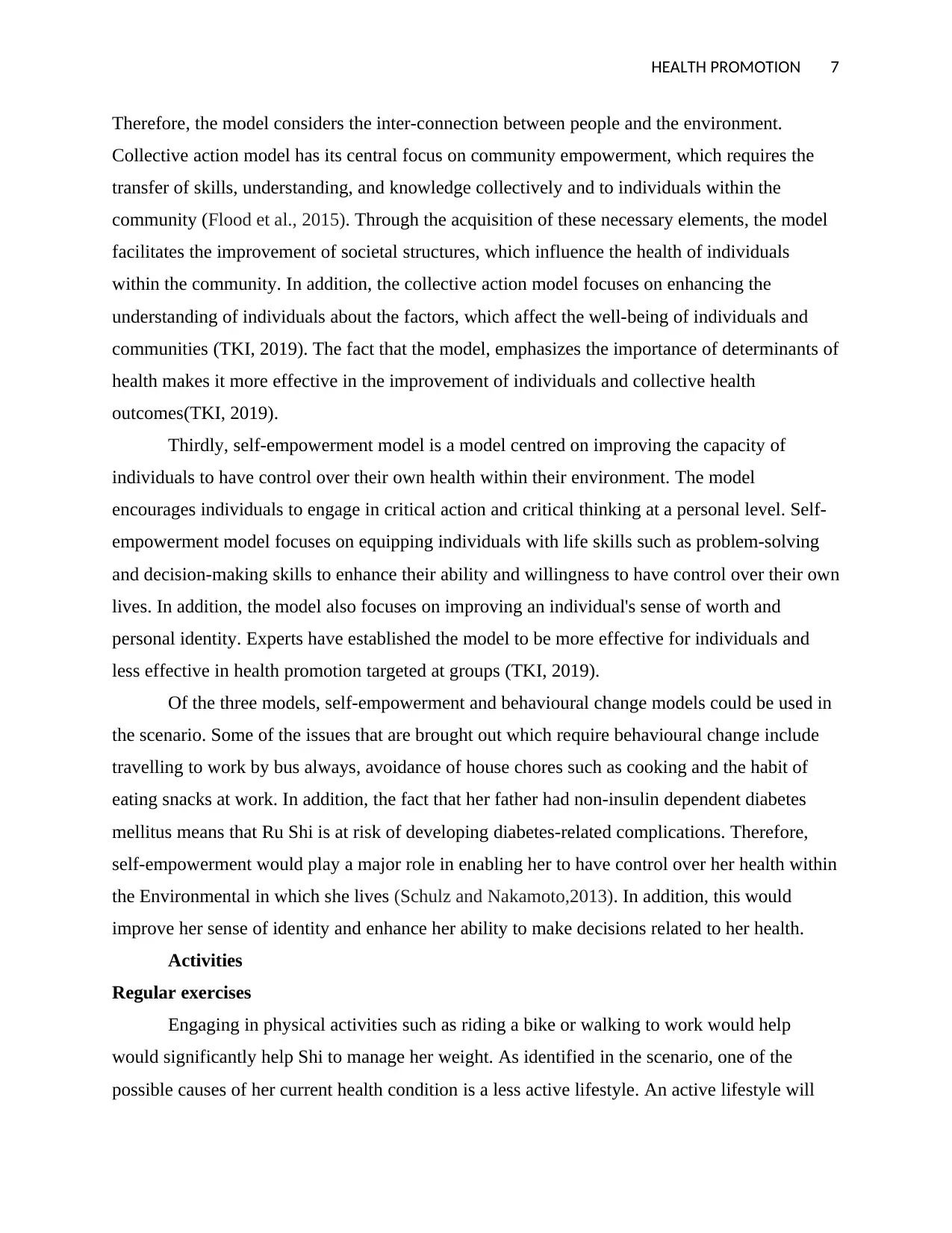
HEALTH PROMOTION 7
Therefore, the model considers the inter-connection between people and the environment.
Collective action model has its central focus on community empowerment, which requires the
transfer of skills, understanding, and knowledge collectively and to individuals within the
community (Flood et al., 2015). Through the acquisition of these necessary elements, the model
facilitates the improvement of societal structures, which influence the health of individuals
within the community. In addition, the collective action model focuses on enhancing the
understanding of individuals about the factors, which affect the well-being of individuals and
communities (TKI, 2019). The fact that the model, emphasizes the importance of determinants of
health makes it more effective in the improvement of individuals and collective health
outcomes(TKI, 2019).
Thirdly, self-empowerment model is a model centred on improving the capacity of
individuals to have control over their own health within their environment. The model
encourages individuals to engage in critical action and critical thinking at a personal level. Self-
empowerment model focuses on equipping individuals with life skills such as problem-solving
and decision-making skills to enhance their ability and willingness to have control over their own
lives. In addition, the model also focuses on improving an individual's sense of worth and
personal identity. Experts have established the model to be more effective for individuals and
less effective in health promotion targeted at groups (TKI, 2019).
Of the three models, self-empowerment and behavioural change models could be used in
the scenario. Some of the issues that are brought out which require behavioural change include
travelling to work by bus always, avoidance of house chores such as cooking and the habit of
eating snacks at work. In addition, the fact that her father had non-insulin dependent diabetes
mellitus means that Ru Shi is at risk of developing diabetes-related complications. Therefore,
self-empowerment would play a major role in enabling her to have control over her health within
the Environmental in which she lives (Schulz and Nakamoto,2013). In addition, this would
improve her sense of identity and enhance her ability to make decisions related to her health.
Activities
Regular exercises
Engaging in physical activities such as riding a bike or walking to work would help
would significantly help Shi to manage her weight. As identified in the scenario, one of the
possible causes of her current health condition is a less active lifestyle. An active lifestyle will
Therefore, the model considers the inter-connection between people and the environment.
Collective action model has its central focus on community empowerment, which requires the
transfer of skills, understanding, and knowledge collectively and to individuals within the
community (Flood et al., 2015). Through the acquisition of these necessary elements, the model
facilitates the improvement of societal structures, which influence the health of individuals
within the community. In addition, the collective action model focuses on enhancing the
understanding of individuals about the factors, which affect the well-being of individuals and
communities (TKI, 2019). The fact that the model, emphasizes the importance of determinants of
health makes it more effective in the improvement of individuals and collective health
outcomes(TKI, 2019).
Thirdly, self-empowerment model is a model centred on improving the capacity of
individuals to have control over their own health within their environment. The model
encourages individuals to engage in critical action and critical thinking at a personal level. Self-
empowerment model focuses on equipping individuals with life skills such as problem-solving
and decision-making skills to enhance their ability and willingness to have control over their own
lives. In addition, the model also focuses on improving an individual's sense of worth and
personal identity. Experts have established the model to be more effective for individuals and
less effective in health promotion targeted at groups (TKI, 2019).
Of the three models, self-empowerment and behavioural change models could be used in
the scenario. Some of the issues that are brought out which require behavioural change include
travelling to work by bus always, avoidance of house chores such as cooking and the habit of
eating snacks at work. In addition, the fact that her father had non-insulin dependent diabetes
mellitus means that Ru Shi is at risk of developing diabetes-related complications. Therefore,
self-empowerment would play a major role in enabling her to have control over her health within
the Environmental in which she lives (Schulz and Nakamoto,2013). In addition, this would
improve her sense of identity and enhance her ability to make decisions related to her health.
Activities
Regular exercises
Engaging in physical activities such as riding a bike or walking to work would help
would significantly help Shi to manage her weight. As identified in the scenario, one of the
possible causes of her current health condition is a less active lifestyle. An active lifestyle will
Paraphrase This Document
Need a fresh take? Get an instant paraphrase of this document with our AI Paraphraser

HEALTH PROMOTION 8
help Shi to control her pre-diabetic condition by lowering blood sugar levels (Changes You Can
Make to Help Control Your Diabetes,2019).
Eating healthy foods
The choice of correct foods would play a major role in the management of weight and
pre-diabetes. The fact that Shi consumes snacks while at work could be used to explain why she
is struggling with weight issues. Snacks are considered to be high fat, high sugar and energy-
dense foods. By engaging in this activity, Shi needs to focus on the consumption of foods such as
whole grains, fruits, and vegetables. By engaging in this activity, she will greatly manage her
calorie intake (Changes You Can Make to Help Control Your Diabetes,2019).
Ethical issues
Ethics is an important consideration in healthcare. Adherence to ethical principles during
health promotion ensures that the rights of individuals are not violated. For health promotion
work to be considered ethical, therefore; they must respect the principles of non-maleficence,
beneficence, justice and autonomy (Saint Joseph's University, 2019).
Autonomy principle requires individuals to whom health promotion efforts are directed
at, to have autonomy of action, intention and thought while making decisions (Salazar,Crosby
and DiClemente,2015). It prohibits healthcare professionals from coercing individuals to make
certain decisions to ensure that they make the right and well-informed decision. The team will,
therefore, have to ensure this principle is not violated. In addition, they will need to inform the
recipient of the potential benefits and risks of health promotion activities as well as the
likelihood of success (Saint Joseph's University, 2019).
The principle of non-maleficence protects individuals from any harm. Individuals
involved in health promotion activities should, therefore, ensure that the activities to which
patients are subjected do not cause any harm (Saint Joseph's University,2019).
Finally, justice and beneficence principle are also important principles that need to be
adhered to. Beneficence requires health professionals to do all that is necessary to benefit
patients at all times. On the other hand, the principle of justice advocates for fairness in all
decisions. Individuals involved in health promotion activities must, therefore, prioritize the
welfare of their patients and ensure that their decisions are fair at all times (Saint Joseph's
University, 2019).
help Shi to control her pre-diabetic condition by lowering blood sugar levels (Changes You Can
Make to Help Control Your Diabetes,2019).
Eating healthy foods
The choice of correct foods would play a major role in the management of weight and
pre-diabetes. The fact that Shi consumes snacks while at work could be used to explain why she
is struggling with weight issues. Snacks are considered to be high fat, high sugar and energy-
dense foods. By engaging in this activity, Shi needs to focus on the consumption of foods such as
whole grains, fruits, and vegetables. By engaging in this activity, she will greatly manage her
calorie intake (Changes You Can Make to Help Control Your Diabetes,2019).
Ethical issues
Ethics is an important consideration in healthcare. Adherence to ethical principles during
health promotion ensures that the rights of individuals are not violated. For health promotion
work to be considered ethical, therefore; they must respect the principles of non-maleficence,
beneficence, justice and autonomy (Saint Joseph's University, 2019).
Autonomy principle requires individuals to whom health promotion efforts are directed
at, to have autonomy of action, intention and thought while making decisions (Salazar,Crosby
and DiClemente,2015). It prohibits healthcare professionals from coercing individuals to make
certain decisions to ensure that they make the right and well-informed decision. The team will,
therefore, have to ensure this principle is not violated. In addition, they will need to inform the
recipient of the potential benefits and risks of health promotion activities as well as the
likelihood of success (Saint Joseph's University, 2019).
The principle of non-maleficence protects individuals from any harm. Individuals
involved in health promotion activities should, therefore, ensure that the activities to which
patients are subjected do not cause any harm (Saint Joseph's University,2019).
Finally, justice and beneficence principle are also important principles that need to be
adhered to. Beneficence requires health professionals to do all that is necessary to benefit
patients at all times. On the other hand, the principle of justice advocates for fairness in all
decisions. Individuals involved in health promotion activities must, therefore, prioritize the
welfare of their patients and ensure that their decisions are fair at all times (Saint Joseph's
University, 2019).

HEALTH PROMOTION 9
Evaluation of the Program
Evaluation in this context may be used to refer to the process of ascertaining the
effectiveness and efficiency of health promotion interventions. The process entails collection and
analysis of information to answer specific questions related to the health intervention program. In
health promotion interventions evaluation is a mandatory requirement. It facilitates the collection
of information about the effectiveness of the program. Additionally, evaluation of a health
promotion program facilitates justification of resources and helps health officials to identify
ways of improving their practice. Finally, an evaluation makes it easy to identify unexpected
outcomes, which might have influenced the success of the promotion. The success of the
program will be evaluated through a number of strategies including (Parry et al.,2013).
Interviews
Interviews are an important methodology in research and evaluation. They take the form
of conversations between the respondent and interviewees through questions and answers. In
health promotion, evaluation interviews present an opportunity for health care officials to seek
answers questions regarding health care intervention activities. With the answers sought from
clients, they can understand if the program was successful(Parry et al.,2013). In using this
approach, Ru Shi will be interviewed at the end of the program to understand if the health
promotion activities helped her meet her objectives. In case her objectives will have been met, it
will be concluded that the promotion was successful. On the contrary, in case she is not satisfied
with the health promotion activities, it will be concluded that the promotion was not successful
(Parry et al.,2013).
Impact evaluation method
Impact evaluation would also be effective in the evaluation of the health promotion program.
Thorough impact evaluation, the impact of the program on the skills of the participant will be
evaluated. In addition, impact evaluation method would be used to measure changes in
behaviours, attitudes, awareness, skills and knowledge. Demonstration of the requisite skills,
knowledge, awareness, skills, behaviours and attitudes by the recipient of the health promotion
efforts will be denoted a success of the promotion and vice versa(Parry et al.,2013).
Conclusion
In conclusion, health promotion is an important aspect of healthcare.It is the process through
which health care professionals help individuals to have increased control of their health. It also
Evaluation of the Program
Evaluation in this context may be used to refer to the process of ascertaining the
effectiveness and efficiency of health promotion interventions. The process entails collection and
analysis of information to answer specific questions related to the health intervention program. In
health promotion interventions evaluation is a mandatory requirement. It facilitates the collection
of information about the effectiveness of the program. Additionally, evaluation of a health
promotion program facilitates justification of resources and helps health officials to identify
ways of improving their practice. Finally, an evaluation makes it easy to identify unexpected
outcomes, which might have influenced the success of the promotion. The success of the
program will be evaluated through a number of strategies including (Parry et al.,2013).
Interviews
Interviews are an important methodology in research and evaluation. They take the form
of conversations between the respondent and interviewees through questions and answers. In
health promotion, evaluation interviews present an opportunity for health care officials to seek
answers questions regarding health care intervention activities. With the answers sought from
clients, they can understand if the program was successful(Parry et al.,2013). In using this
approach, Ru Shi will be interviewed at the end of the program to understand if the health
promotion activities helped her meet her objectives. In case her objectives will have been met, it
will be concluded that the promotion was successful. On the contrary, in case she is not satisfied
with the health promotion activities, it will be concluded that the promotion was not successful
(Parry et al.,2013).
Impact evaluation method
Impact evaluation would also be effective in the evaluation of the health promotion program.
Thorough impact evaluation, the impact of the program on the skills of the participant will be
evaluated. In addition, impact evaluation method would be used to measure changes in
behaviours, attitudes, awareness, skills and knowledge. Demonstration of the requisite skills,
knowledge, awareness, skills, behaviours and attitudes by the recipient of the health promotion
efforts will be denoted a success of the promotion and vice versa(Parry et al.,2013).
Conclusion
In conclusion, health promotion is an important aspect of healthcare.It is the process through
which health care professionals help individuals to have increased control of their health. It also
⊘ This is a preview!⊘
Do you want full access?
Subscribe today to unlock all pages.

Trusted by 1+ million students worldwide
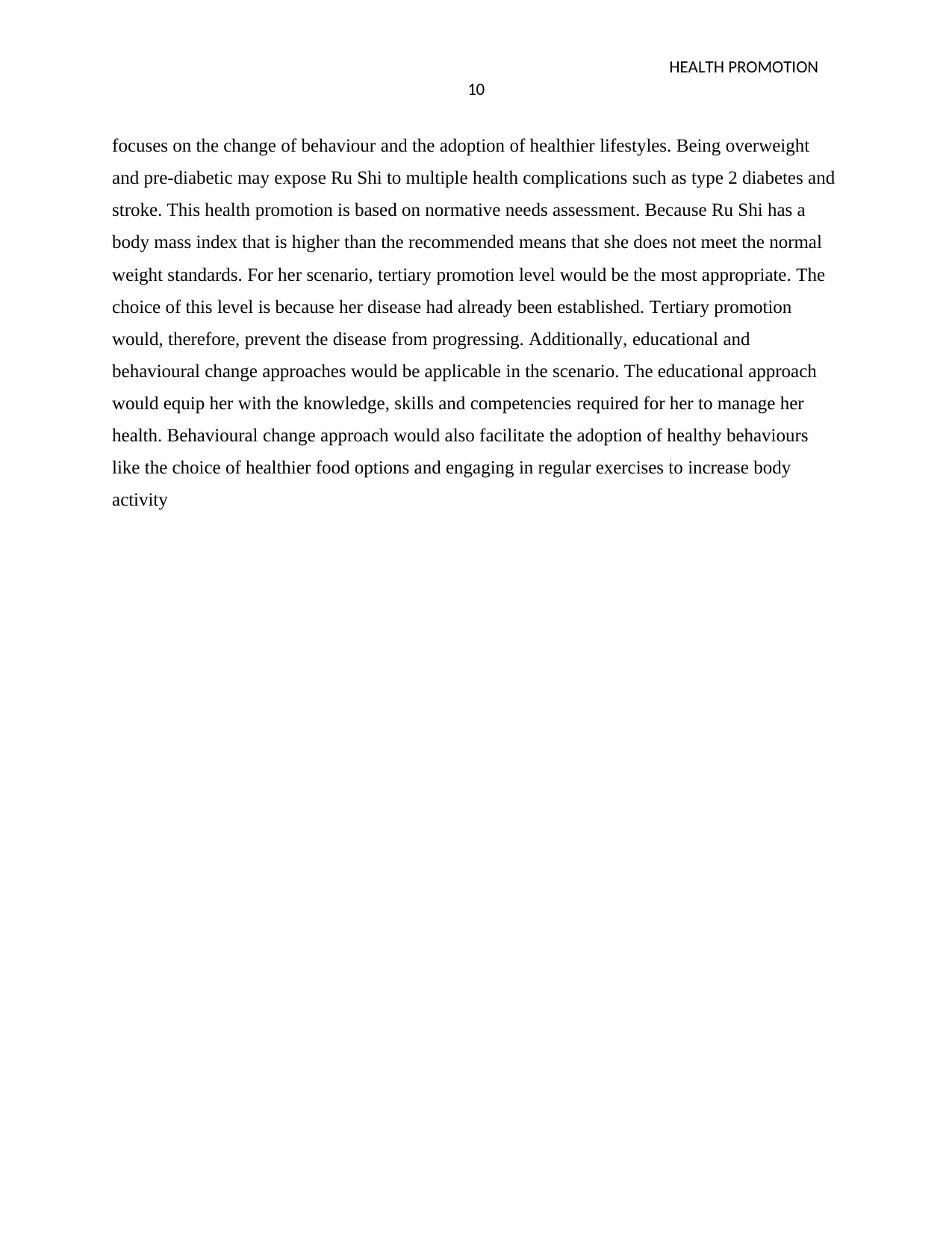
HEALTH PROMOTION
10
focuses on the change of behaviour and the adoption of healthier lifestyles. Being overweight
and pre-diabetic may expose Ru Shi to multiple health complications such as type 2 diabetes and
stroke. This health promotion is based on normative needs assessment. Because Ru Shi has a
body mass index that is higher than the recommended means that she does not meet the normal
weight standards. For her scenario, tertiary promotion level would be the most appropriate. The
choice of this level is because her disease had already been established. Tertiary promotion
would, therefore, prevent the disease from progressing. Additionally, educational and
behavioural change approaches would be applicable in the scenario. The educational approach
would equip her with the knowledge, skills and competencies required for her to manage her
health. Behavioural change approach would also facilitate the adoption of healthy behaviours
like the choice of healthier food options and engaging in regular exercises to increase body
activity
10
focuses on the change of behaviour and the adoption of healthier lifestyles. Being overweight
and pre-diabetic may expose Ru Shi to multiple health complications such as type 2 diabetes and
stroke. This health promotion is based on normative needs assessment. Because Ru Shi has a
body mass index that is higher than the recommended means that she does not meet the normal
weight standards. For her scenario, tertiary promotion level would be the most appropriate. The
choice of this level is because her disease had already been established. Tertiary promotion
would, therefore, prevent the disease from progressing. Additionally, educational and
behavioural change approaches would be applicable in the scenario. The educational approach
would equip her with the knowledge, skills and competencies required for her to manage her
health. Behavioural change approach would also facilitate the adoption of healthy behaviours
like the choice of healthier food options and engaging in regular exercises to increase body
activity
Paraphrase This Document
Need a fresh take? Get an instant paraphrase of this document with our AI Paraphraser
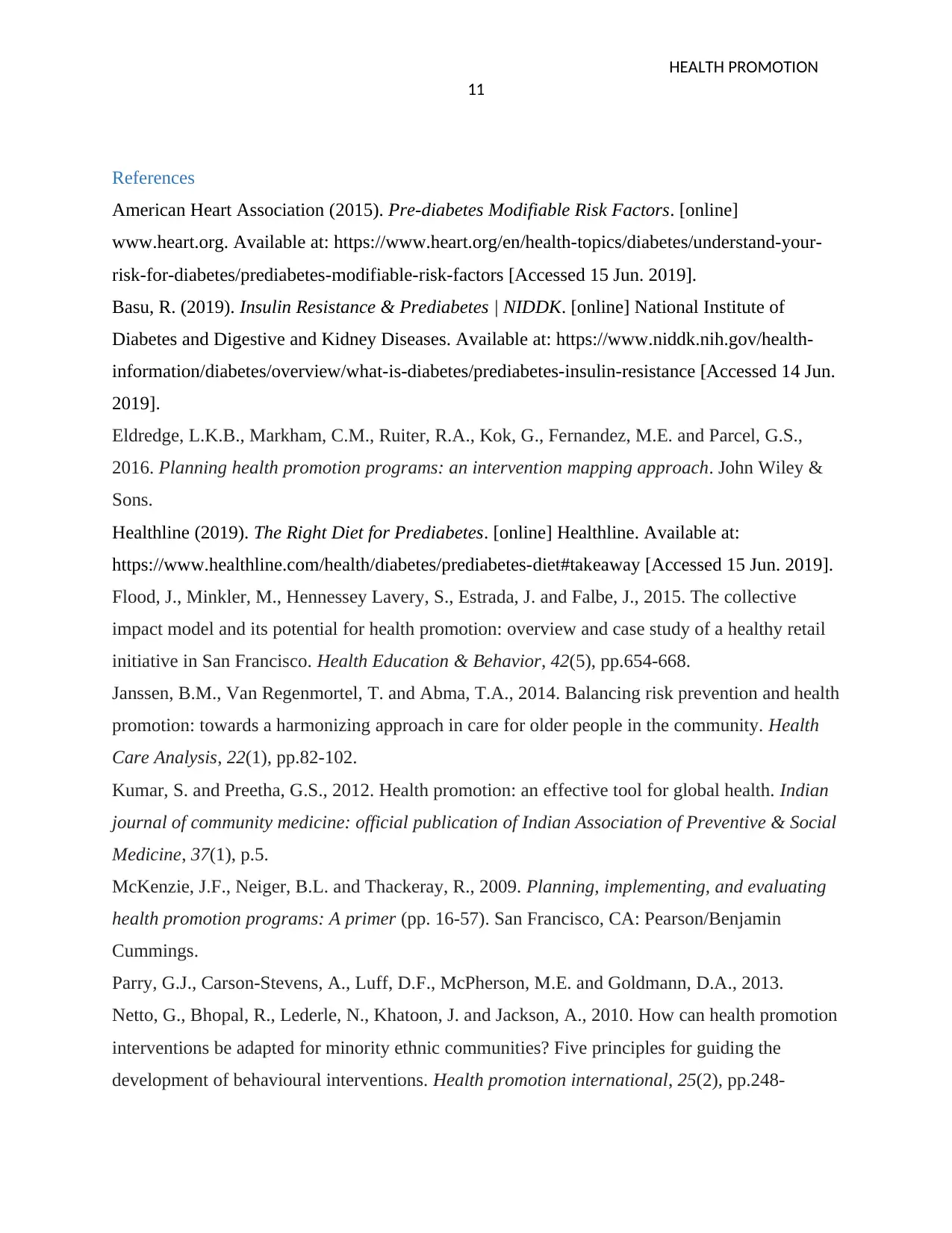
HEALTH PROMOTION
11
References
American Heart Association (2015). Pre-diabetes Modifiable Risk Factors. [online]
www.heart.org. Available at: https://www.heart.org/en/health-topics/diabetes/understand-your-
risk-for-diabetes/prediabetes-modifiable-risk-factors [Accessed 15 Jun. 2019].
Basu, R. (2019). Insulin Resistance & Prediabetes | NIDDK. [online] National Institute of
Diabetes and Digestive and Kidney Diseases. Available at: https://www.niddk.nih.gov/health-
information/diabetes/overview/what-is-diabetes/prediabetes-insulin-resistance [Accessed 14 Jun.
2019].
Eldredge, L.K.B., Markham, C.M., Ruiter, R.A., Kok, G., Fernandez, M.E. and Parcel, G.S.,
2016. Planning health promotion programs: an intervention mapping approach. John Wiley &
Sons.
Healthline (2019). The Right Diet for Prediabetes. [online] Healthline. Available at:
https://www.healthline.com/health/diabetes/prediabetes-diet#takeaway [Accessed 15 Jun. 2019].
Flood, J., Minkler, M., Hennessey Lavery, S., Estrada, J. and Falbe, J., 2015. The collective
impact model and its potential for health promotion: overview and case study of a healthy retail
initiative in San Francisco. Health Education & Behavior, 42(5), pp.654-668.
Janssen, B.M., Van Regenmortel, T. and Abma, T.A., 2014. Balancing risk prevention and health
promotion: towards a harmonizing approach in care for older people in the community. Health
Care Analysis, 22(1), pp.82-102.
Kumar, S. and Preetha, G.S., 2012. Health promotion: an effective tool for global health. Indian
journal of community medicine: official publication of Indian Association of Preventive & Social
Medicine, 37(1), p.5.
McKenzie, J.F., Neiger, B.L. and Thackeray, R., 2009. Planning, implementing, and evaluating
health promotion programs: A primer (pp. 16-57). San Francisco, CA: Pearson/Benjamin
Cummings.
Parry, G.J., Carson-Stevens, A., Luff, D.F., McPherson, M.E. and Goldmann, D.A., 2013.
Netto, G., Bhopal, R., Lederle, N., Khatoon, J. and Jackson, A., 2010. How can health promotion
interventions be adapted for minority ethnic communities? Five principles for guiding the
development of behavioural interventions. Health promotion international, 25(2), pp.248-
11
References
American Heart Association (2015). Pre-diabetes Modifiable Risk Factors. [online]
www.heart.org. Available at: https://www.heart.org/en/health-topics/diabetes/understand-your-
risk-for-diabetes/prediabetes-modifiable-risk-factors [Accessed 15 Jun. 2019].
Basu, R. (2019). Insulin Resistance & Prediabetes | NIDDK. [online] National Institute of
Diabetes and Digestive and Kidney Diseases. Available at: https://www.niddk.nih.gov/health-
information/diabetes/overview/what-is-diabetes/prediabetes-insulin-resistance [Accessed 14 Jun.
2019].
Eldredge, L.K.B., Markham, C.M., Ruiter, R.A., Kok, G., Fernandez, M.E. and Parcel, G.S.,
2016. Planning health promotion programs: an intervention mapping approach. John Wiley &
Sons.
Healthline (2019). The Right Diet for Prediabetes. [online] Healthline. Available at:
https://www.healthline.com/health/diabetes/prediabetes-diet#takeaway [Accessed 15 Jun. 2019].
Flood, J., Minkler, M., Hennessey Lavery, S., Estrada, J. and Falbe, J., 2015. The collective
impact model and its potential for health promotion: overview and case study of a healthy retail
initiative in San Francisco. Health Education & Behavior, 42(5), pp.654-668.
Janssen, B.M., Van Regenmortel, T. and Abma, T.A., 2014. Balancing risk prevention and health
promotion: towards a harmonizing approach in care for older people in the community. Health
Care Analysis, 22(1), pp.82-102.
Kumar, S. and Preetha, G.S., 2012. Health promotion: an effective tool for global health. Indian
journal of community medicine: official publication of Indian Association of Preventive & Social
Medicine, 37(1), p.5.
McKenzie, J.F., Neiger, B.L. and Thackeray, R., 2009. Planning, implementing, and evaluating
health promotion programs: A primer (pp. 16-57). San Francisco, CA: Pearson/Benjamin
Cummings.
Parry, G.J., Carson-Stevens, A., Luff, D.F., McPherson, M.E. and Goldmann, D.A., 2013.
Netto, G., Bhopal, R., Lederle, N., Khatoon, J. and Jackson, A., 2010. How can health promotion
interventions be adapted for minority ethnic communities? Five principles for guiding the
development of behavioural interventions. Health promotion international, 25(2), pp.248-
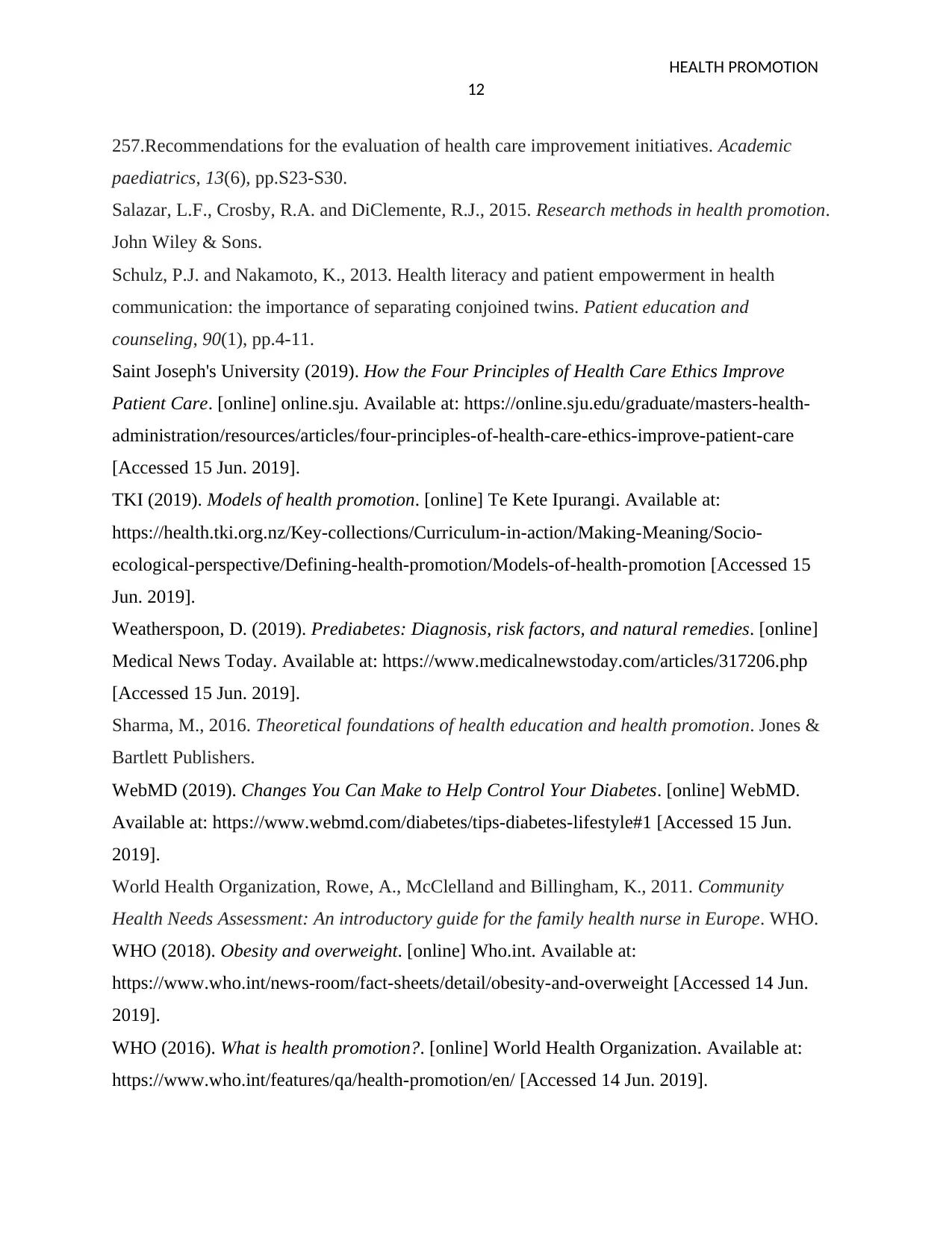
HEALTH PROMOTION
12
257.Recommendations for the evaluation of health care improvement initiatives. Academic
paediatrics, 13(6), pp.S23-S30.
Salazar, L.F., Crosby, R.A. and DiClemente, R.J., 2015. Research methods in health promotion.
John Wiley & Sons.
Schulz, P.J. and Nakamoto, K., 2013. Health literacy and patient empowerment in health
communication: the importance of separating conjoined twins. Patient education and
counseling, 90(1), pp.4-11.
Saint Joseph's University (2019). How the Four Principles of Health Care Ethics Improve
Patient Care. [online] online.sju. Available at: https://online.sju.edu/graduate/masters-health-
administration/resources/articles/four-principles-of-health-care-ethics-improve-patient-care
[Accessed 15 Jun. 2019].
TKI (2019). Models of health promotion. [online] Te Kete Ipurangi. Available at:
https://health.tki.org.nz/Key-collections/Curriculum-in-action/Making-Meaning/Socio-
ecological-perspective/Defining-health-promotion/Models-of-health-promotion [Accessed 15
Jun. 2019].
Weatherspoon, D. (2019). Prediabetes: Diagnosis, risk factors, and natural remedies. [online]
Medical News Today. Available at: https://www.medicalnewstoday.com/articles/317206.php
[Accessed 15 Jun. 2019].
Sharma, M., 2016. Theoretical foundations of health education and health promotion. Jones &
Bartlett Publishers.
WebMD (2019). Changes You Can Make to Help Control Your Diabetes. [online] WebMD.
Available at: https://www.webmd.com/diabetes/tips-diabetes-lifestyle#1 [Accessed 15 Jun.
2019].
World Health Organization, Rowe, A., McClelland and Billingham, K., 2011. Community
Health Needs Assessment: An introductory guide for the family health nurse in Europe. WHO.
WHO (2018). Obesity and overweight. [online] Who.int. Available at:
https://www.who.int/news-room/fact-sheets/detail/obesity-and-overweight [Accessed 14 Jun.
2019].
WHO (2016). What is health promotion?. [online] World Health Organization. Available at:
https://www.who.int/features/qa/health-promotion/en/ [Accessed 14 Jun. 2019].
12
257.Recommendations for the evaluation of health care improvement initiatives. Academic
paediatrics, 13(6), pp.S23-S30.
Salazar, L.F., Crosby, R.A. and DiClemente, R.J., 2015. Research methods in health promotion.
John Wiley & Sons.
Schulz, P.J. and Nakamoto, K., 2013. Health literacy and patient empowerment in health
communication: the importance of separating conjoined twins. Patient education and
counseling, 90(1), pp.4-11.
Saint Joseph's University (2019). How the Four Principles of Health Care Ethics Improve
Patient Care. [online] online.sju. Available at: https://online.sju.edu/graduate/masters-health-
administration/resources/articles/four-principles-of-health-care-ethics-improve-patient-care
[Accessed 15 Jun. 2019].
TKI (2019). Models of health promotion. [online] Te Kete Ipurangi. Available at:
https://health.tki.org.nz/Key-collections/Curriculum-in-action/Making-Meaning/Socio-
ecological-perspective/Defining-health-promotion/Models-of-health-promotion [Accessed 15
Jun. 2019].
Weatherspoon, D. (2019). Prediabetes: Diagnosis, risk factors, and natural remedies. [online]
Medical News Today. Available at: https://www.medicalnewstoday.com/articles/317206.php
[Accessed 15 Jun. 2019].
Sharma, M., 2016. Theoretical foundations of health education and health promotion. Jones &
Bartlett Publishers.
WebMD (2019). Changes You Can Make to Help Control Your Diabetes. [online] WebMD.
Available at: https://www.webmd.com/diabetes/tips-diabetes-lifestyle#1 [Accessed 15 Jun.
2019].
World Health Organization, Rowe, A., McClelland and Billingham, K., 2011. Community
Health Needs Assessment: An introductory guide for the family health nurse in Europe. WHO.
WHO (2018). Obesity and overweight. [online] Who.int. Available at:
https://www.who.int/news-room/fact-sheets/detail/obesity-and-overweight [Accessed 14 Jun.
2019].
WHO (2016). What is health promotion?. [online] World Health Organization. Available at:
https://www.who.int/features/qa/health-promotion/en/ [Accessed 14 Jun. 2019].
⊘ This is a preview!⊘
Do you want full access?
Subscribe today to unlock all pages.

Trusted by 1+ million students worldwide
1 out of 13
Related Documents
Your All-in-One AI-Powered Toolkit for Academic Success.
+13062052269
info@desklib.com
Available 24*7 on WhatsApp / Email
![[object Object]](/_next/static/media/star-bottom.7253800d.svg)
Unlock your academic potential
Copyright © 2020–2025 A2Z Services. All Rights Reserved. Developed and managed by ZUCOL.





